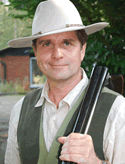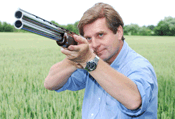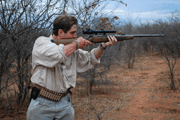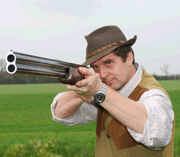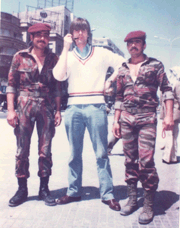High Birds
Well, we’re getting to that time of year again, the time of year when the birds are high, wild and wiley and are likely to challenge all your shooting skills. I have a number of friends who routinely change from 6 shot to 5 shot at this time of year. I don’t copy them though, needing all the help I can get, I use nothing but 5 shot now through a 32” Guerini 20 bore. There is much to be said for that old saying ‘beware the man with one gun’, it might be modified, however: ‘beware the man with one gun and one cartridge - he is likely to know both well’.
You may be aware of experiments that BASC have carried out which indicated the advantage of the larger pellet. My mate Brian Jackson, of Lylavale Express, a most experienced, cartridge guy is of the same opinion (but also warns of the folly of stuffing roman candle loads into normal guns and then wondering why you are getting bashed up): “It’s simple physics really, the 5s retain and deliver energy better than smaller pellets, but you don’t need to supercharge them to get good results”.
That was enough for me. I switched last season and have not looked back since. The only time I will change now is when facing really stratospheric high birds or wildfowl when an even bigger pellet may be called for. My standard load, however, is 30 grams of 5s through my quite hefty, 20. I was, I might note, using some 32s as well - a lot for a 20 bore - but found no great advantage and now stick to fibre wad 30s.
I have been lucky in recent years. I have had the opportunity to shoot quite lot of high birds thanks to the generosity of friends. I am always testing ideas and methods to provide fodder for articles like this and to develop my own understanding of a fascinating subject. Sir Ralph Payne-Gallwey became so enamored of high birds that he devoted a book to the subject in 1913: Shooting High Pheasants in Theory and Practice. He was not a great fan of choke and liked smaller shot - 7s. I can’t agree with him completely (although I am a great admirer of his work and his sheer sporting stamina).
Over the last three seasons I have tried out all sorts of guns, all sorts of cartridges and all sorts of shooting methods. I achieved some success using a 30” Beretta 28 bore EELL with an ounce of 6s and three-quarters and three-quarters choke. The way this ‘kill or miss’ combination worked surprised a lot of people and I grew confident with it (always vitally important). My performance with the more open (1/4 and ½), long-barrelled, 20 has been a little bit better, however.
I now prefer using this to a 12, moreover, the gun moves so well. If a 12 bore works for you, however, stick with it – we don’t all have to be the same. My advice would be for a fairly open first barrel combined with ½ or ¾ in the second. I would not go for a 32” gun in 12 unless the barrels were relatively light. 30” is usually the way to go. My preference in a side by side might be 28, 29 or 30” depending on the weight of the gun (I like a gun weighing about 7lbs). Some clay guns can be pressed into useful service for high birds. And, to pull one other from the pack, the Miroku MK38 - one of the best value guns on the British market - is not only a great clay buster but super tool for West Country or Welsh valleys as well.
But, let’s not get hung up on the kit. When facing any bird, you always have three things to consider - lead, line and speed. With high birds, it all becomes more critical and there is much less room for error. As always, let’s try and keep it simple. If you are facing a bird at 40 yards (and my advice would not be to shoot much beyond this on any regular basis) you are going to need to put your shot - one way or another - about 8 feet in front of it, maybe more if the wind is blowing up its backside to any extent.
Most people don’t do that. They are used to shooting birds 20-25 yards away that might require a few feet of lead and simply are outside their comfort zone when they start engaging the higher stuff. If your havig problems with high birds go and practice on high towers at a local shooting school. You might also benefit hugely from an experienced ‘loader-minder’ on your first high bird shoot or two who can give them good quality feedback on where they are missing.
There are some instructors who make a specialty out of teaching ‘on the peg,’ Glyn Davies of North Wales, for example, who shares very similar view to my own and who has enormous experience of high bird shooting (as well as competition): “People need to put effort into reading the height and speed of the bird...they shouldn’t get too complicated...following from behind, moving through, pulling the tirgger and, critically, keeping the gun moving.”
Glyn is no fan of maintained lead for high bird work, and I agree (although there is no harm in understanding that you need to be a good distance in front of a bird at range): “most people get in a muddle when they start to track them and shoot...I am great believer in going back to basics, traditional stuff - bum, belly beak and getting that gun moving ten miles an hour so more than the bird.” See More on Forward Allowance Here.
This will, of course, make sure that you’re keeping your gun in front of the bird. There is no need to rush, everything should be done smoothly and at a sensible pace ONE:TWO:THREEEE, or as one old gamekeeper put it YOU:ARE:DEAD! Anything else? Don’t forget your footwork and balance. Try and keep the front shoulder over the front foot and the weight forward without any unnecessary lean. Head on the stock all the way through the shot.
Many let the weight come back as they swing, the head rises and the gun stops. Move your feet when you can. If the bird is going right or left of centre, step into its line. Just a small step, no clod hopping, just a few inches leading with the front foot is required when the ground allows. The idea should always be to shoot without excessive tension in your body and with your eye or eyes firmly locked on head or beak. Here’s my final advice, keep pushing up with the front arm and keep the barrels on line.
The adrenaline junkies think you should whip though it but you have plenty of time, come on to the tail feathers smoothly, pull the trigger as you pass through and keep going...”


